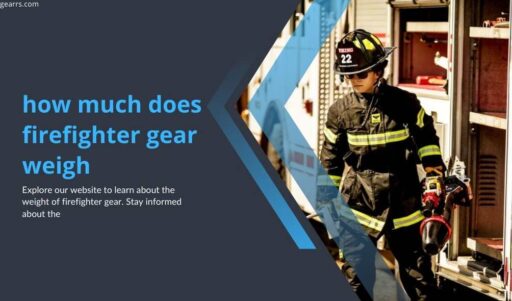Introduction To Firefighter Gear
Firefighter’s gear is a uniform. However, it is also necessary to have equipment that protects them from threats they may encounter. Understanding the weight of firefighter gear is vital. It directly affects our ability to do our job safely and well. This guide will analyze many aspects of the weight of firefighter gear. It covers the components, average weight, determinants, and safety considerations. Therefore, let us see How Much Firefighter Gear Weigh firefighters wear weighs, and in so doing, it means we will have gained more insight into its importance.
Firefighter gear typically weighs between 45 and 75 pounds (20 to 34 kilograms). This includes their basic protective equipment (helmet, hood, pants, coat, gloves, boots, and air pack). How Much Does Firefighter Gear Weigh, the total weight can increase depending on the situation. Firefighters might carry additional tools like thermal imaging cameras, radios, and axes, adding up to 75 lbs or more.
Importance of understanding the weight of firefighter gear
Credit: Graham Fire & Rescue
It is vital for a firefighter or his commanders to know the amount their gears weigh. The weight of his firefighting gear affects a firefighter. It hurts his mobility, endurance, and performance in emergencies. It also helps firefighters learn about this feature. It allows them to train, build strength, and take precautions against injuries or fatigue. Also, knowing a firefighter’s weight helps departments. It helps them develop training, allocate resources, and find new ways to reduce the burden on fighters.
The components of firefighter gear
Firefighting gear is a combination of several elements. They help protect us from heat, fire, smoke, and other dangers. The key components include helmets, jackets, trousers, gloves, boots, and SCBA. All these parts can withstand extreme heat. They also offer insulation and protection from physical harm. These parts are carefully designed and tested before being sold to meet national safety standards. They provide the highest level of defense for firefighters. Moreover, each part has different materials and construction methods. They add to the total mass of this setup.
Average weight of firefighter gear
Fire-fighting clothing’s heaviness may vary. It depends on factors such as who made them, the design chosen, and extra features. Usually, firefighter’s gear can weigh between 45 to 75 pounds (20 to 34 kilograms). This weight includes SCBA, which alone weighs around 25 to 30 pounds (11 to 13 kilograms). The turnout coat and pants add a lot to the load. They typically weigh 15 to 20 pounds (7 to 9 kilograms) each. Also, helmets, gloves, and boots add a few more pounds. But they provide full protection for a firefighter.
Factors that affect the weight of firefighter gear
There are various aspects that contribute to the total massiveness associated with firefighting equipment. These are mainly relied upon in order to get the reasonable weights required. For example, firefighting gear needs much higher temperatures. It also needs better insulation than ordinary gear. So, it is heavier. Moreover, the kind of materials used in its construction will also matter a lot. These are cheap. They provide high protection. But Kevlar or Nomex are extra expenses. Partners have to pay for them. Finally, the weight of this outfit also relies on its designs. Some innovative ones could be seen. They seem to consider how to maintain safety. But, much importance is attached to their lightness.
How Much Does Firefighter Gear Weigh to properly wear and carry firefighter gear
Putting on firefighting attire must be done correctly. This is to avoid straining your body unnecessarily. It allows for optimal mobility during emergencies. Here are some guidelines:
Donning the gear: Start by putting on the pants and boots, followed by the turnout coat. Ensure that all fasteners are secure so that there are no loose ends left behind or any air gaps in them that can compromise your safety when you want it most.
Helmet adjustment: Fit the helmet on your head in a way that makes it comfortable and does not obstruct either of your senses, sight, or hearing.
SCBA placement: Place the SCBA firmly behind you, ensuring the straps are tight and the weight is distributed evenly.
Gloves and hood: Put on gloves and a hood to protect your hands and head from heat and smoke.
Proper lifting techniques are key. They help you avoid strain or injury while carrying heavy things. Bend your knees, keep your back straight, and lift with your legs.
Training for carrying heavy firefighter gear
To carry heavy firefighter gear well, one must be strong. They also need stamina and proper technique. Firefighter departments emphasize physical fitness training. It is part of their preparation for fire emergencies. It helps them withstand the weight of their gear. These programs include strength training, cardio, and functional movements. These movements resemble firefighting tasks. Moreover, firefighters may be subjected to simulations so that they can go through real-life situations wearing the gear. By doing this, they will have built up endurance while using this weight, thus better equipping them during an emergency situation.
Innovative solutions to reduce the weight of firefighter gear
Manufacturers and researchers recognize that heavy gear is very physically demanding. It also carries health risks. Therefore, these individuals strive hard to find innovative ways through which their weight can be reduced further. An example is developing firefighting clothing with lightweight fabrics. Materials like these maintain the level of protection needed but at lower weights generally. Additionally, companies are looking at ergonomics. It tries to distribute the load more evenly. This reduces stress on body parts such as shoulders and back, where most load is felt. Advancements include integrated cooling systems and self-adjusting straps. They are added to raise comfort while lightening firefighters’ loads.
Safety considerations when wearing heavy firefighter gear
When putting on heavy firefighter gear, safety has to be observed. Firefighters need to understand the physical limits of their heavy gear. They need to be cautious to avoid injury and fatigue. Strenuous exercise programs aimed at building resilience for firefighting activities will, therefore, be necessary. At the same time, there has to be adequate resting time intervals so as to avoid overworking the body. Lastly, departments should emphasize teamwork and good communication since firefighting is a physically draining job.
Strategies to Manage Gear Weight
Proper Fitness and Training
This way firefighters can maintain capability under load through physical strength and conditioning at all times. Therefore departments may have rigorous fitness programs and also trainings involving weights in order to reflect what they will actually have on them.
Equipment Innovations
These days, it is possible for the industry to produce materials that are both lighter but still more durable than their predecessors without compromising on protection capacity in any way. That is why we always hear about new fibers such as high-tech fabrics or carbon-fiber reinforced tools that are being developed every now and then which aim at lightening this burden.
Team Support and Rotation
By rotating gear and tasks among members, teams can limit fatigue while maximizing their effectiveness.. It is important that gear distribution takes into account both the role of individual firefighters and operation requirements thus enabling balance.
Frequently Ask Question
Can firefighter gear have different weights depending on the department?
Yes, firefighter gear can vary in weight according to various departments depending on specification requirements, money allocation, and available resources within a particular jurisdiction.
Are there any regulations or standards regarding the weight of firefighter gear?
Absolutely; national and international safety standards govern the design, make, and performance of fire fighting equipment. Those standards guarantee that this equipment will provide sufficient protection while minimizing the risks of injuries.
Is it possible for firefighters to personalize their gear without compromising its safety?
Personalization can be done on certain parts of a firefighter’s equipment, like reflective patches or name tags. However, such changes must never interfere with How Much Does Firefighter Gear Weigh well the gear is in use since it should not lose its performance.
Conclusion of How Much Does Firefighter Gear Weigh
For all firefighters and their departments, understanding the weight of firefighter gear is essential. It affects their productivity, safety, and general ability to respond efficiently during emergencies. Firefighters can better prepare themselves physically by knowing what constitutes firefighting outfits, average weights as well as factors affecting them and How Much Does Firefighter Gear Weigh they are linked to matters concerning safety in their industry.
Also, ongoing research plus innovations in materials and design offer promise for lightening these loads without compromising safety. As technology advances and awareness grows, it is crucial for firefighters and their departments to stay updated and implement best practices to ensure the well-being of our brave heroes.
CTA: Get subscribed today for our newsletters so that you can get more information on firefighter gear advancements as well as safety protocols. Sign up now to receive private updates from experts only. Through this, let’s make sure that we do not allow ourselves to be affected by the weight attached to firefighter apparel when going about our work, which is safeguarding lives.






